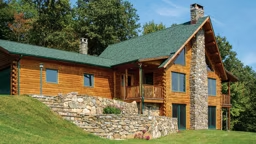
There is nothing “typical” about log and timber frame homes. Their exceptional beauty and long-lasting construction are what drive us to yearn for them in the first place. But, this uniqueness can result in a lack of understanding in the conventional building community, and as such, the vast majority of building authorities in the United States and Canada require approval from a structural engineer.
We turned to Brian J. Sielaff, founder and managing member of Boise, Idaho-based Tamarack Grove Engineering, for advice on how to navigate this process effectively. Brian has more than 25 years of experience engineering log and timber frame homes and is licensed in all 50 states and all Canadian provinces.
“For starters, I encourage homeowners to do their due diligence when taking on a new home project. Take ownership of it, so that you’re not blindsided by circumstances beyond your control. Don’t just take a builder’s or contractor’s assurances,” Brian says.
While it does mean homework for the home buyer, this cautious approach is the best way to ensure you get the home you want while protecting your budget.
Site Concerns
Before purchasing land outright, employ a contingency agreement — usually for 60 to 90 days — with the seller to discover if it’s a buildable parcel, Brian advises. “My wife and I were looking to build, and we found property that seemed promising. But after looking into it, the county required unusually deep setbacks. We discovered we would have to put in a long driveway that would cost more than $250,000 to install.”
Knowing the buildability of a piece of property before you buy is also important. Brian recommends investing in a soil analysis to ensure that you won’t run into issues. For example, in the western U.S., it’s not uncommon to find expansive soil, which absorbs water and expands as a result. This type of soil is known to cause cracks in foundations and floors, causing expensive repairs down the road.
Factor in Floodplains
The Federal Emergency Management Agency (FEMA) has classified thousands of communities as being in floodplains. “Being in a floodplain may not preclude you from building there, but it will likely increase costs,” cautions Brian.
If you plan to build on the coast, for example, you will need an elevation certificate to obtain flood insurance. The certificate lists the building location, lowest elevation, flood zone and other characteristics. Often, your first floor will need to be 10 to 15 feet above a “100-year storm” event and will require impact-resistant doors and windows to withstand hurricane-force winds.
The Designer’s Importance
When it comes to design, Brian recommends using only a registered architect licensed for the state where you are building. This can be an independent architect or an in-house designer with a log or timber home manufacturer.
“Anybody can make lines on paper and call themselves a designer,” Brian warns (Tamarack Grove has its own in-house architect), “so insist on detailed construction drawings from the architect or designer you choose.
“Avoid gray areas where it’s not completely clear in the drawings what needs to be built, because that can lead to extensive change orders, which can dramatically affect your budget,” he continues. “You don’t want to pull money out of your retirement fund for overruns.”
Meeting Codes
If you’re building with logs, make sure both the log provider you choose and your builder are familiar with the ICC-400-2017 construction standard. This standard establishes the minimum requirements for log structures. The five components of the standard include log grading, fire resistance, energy conservation, settling provisions and wall protection.
Likewise, ever-tightening energy codes may require a minimum of 8-inch-diameter logs in some locations, so make sure the type of log package you’re considering is compliant with the region in which you intend to build, Brian advises.
Thanks to catastrophic wildfires across the West, many areas are changing their fire codes to help mitigate damages in the event of a fire. For instance, Brian says municipalities are requiring more fire-resistant decking. While one can glean information online, nothing beats a direct call to the local building official or fire marshal who will be approving your plan to help discern what they like to see in a new home’s design.
Every jurisdiction will have its own guidelines, since municipalities update their codes at a time of their own choosing. “They might use the 2003 IRC [International Residential Code], or it might be the 2018 version. You won’t know until you start your research,” Brian says.
Choosing the Right Structural Engineer
Just as with everything in life, there are unethical engineers who will rubber stamp any plan. But that route can be disastrous for your investment, not to mention your safety. Fortunately, there are some strategies to employ that can help you weed out the good from the bad.
“Much like with a general contractor or a log or timber frame manufacturer, always check references,” advises Brian. As you review engineering proposals and fee structures, make sure each one covers the same scope of work in its deliverables. Ask the tough and sometimes awkward questions, like the following:
- How many projects has your company done?
- Is your firm licensed as a professional engineer in the state where my project is located?
- Have you ever done any other projects within my local jurisdiction (AHJ)?
- Does your firm carry the necessary professional liability insurance in the event that something was engineered wrong?
- Does your firm carry any Errors and Omissions Insurance (E&O), and if so, what are your limits?
- Can your firm meet my required schedule in order to submit my construction documents for permit?
In short, to execute a project correctly, it will take time to review andperform the necessary engineering process. A structural engineering firm’s fee should factor in all of the required duties, their time, their coordination, their exposure, their professional engineering license and then their professional E&O insurances. Make sure that the proposed fee covers all of the above, and if it does, you will be on track to hiring a quality engineer and giving yourself peace of mind.











